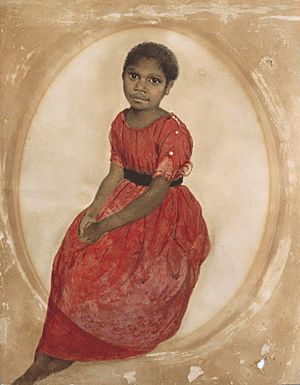Mathinna (Tasmanian) facts for kids
Quick facts for kids
Mathinna
|
|
|---|---|

Mathinna - 1842 watercolour by Thomas Bock
|
|
| Born | 1835 |
| Died | 1852 (aged 16–17) Oyster Cove, Tasmania, Australia
|
| Known for | Adopted daughter of Sir John Franklin |
Mathinna (1835–1852) was a young Aboriginal Tasmanian girl. She became well-known because she was adopted by Sir John Franklin, who was the Governor of Tasmania at the time. Sadly, she was later left on her own.
Contents
Mathinna's Early Life
Mathinna was born in 1835 on Flinders Island, which is part of Tasmania, Australia. Her birth name was Mary. Her father, Towgerer, was a chief of the Lowreenne tribe, and her mother was Wongerneep. In 1833, her tribe was moved to a settlement by George Augustus Robinson, who was in charge of Aboriginal affairs. When Mary was about six years old, her name was changed to Mathinna.
Living with the Governor's Family
In 1837, Sir John Franklin became the Lieutenant Governor of Van Diemen's Land (which is now Tasmania). He and his wife, Lady Jane Franklin, wanted an Aboriginal child to live with them. Mathinna was sent to Hobart to live at Government House with the Franklins. Even though she had parents, she was chosen to live with them. She grew up alongside the Franklins' daughter, Eleanor.
We have only a small part of a letter written by Mathinna. It shows how different her life must have been, moving from her family on Flinders Island to the Governor's grand house in Hobart. She wrote:
I am good little girl, I have pen and ink cause I am a good little girl . . . . I have a got a red frock like my father. Come here to see my father. I have got sore feet and shoes and stockings and I am very glad.
Life After the Franklins
When Sir John Franklin was called back to England, he and Lady Franklin left Mathinna. This happened in 1843, and Mathinna was only eight years old. She was placed in the Queen’s Orphan School in Hobart. It was very hard for her to get used to her new life there.
In 1844, when she was nine, Mathinna was sent back to Flinders Island. However, she was later returned to the Queen's Orphan School. In 1851, when she was about 16, she moved to the Aboriginal settlement at Oyster Cove, which is west of Hobart.
Mathinna passed away on September 1, 1852. She was either 17 or 18 years old.
Mathinna's Legacy
It is thought that Mathinna was buried in the Aboriginal cemetery at Oyster Cove. In 1907, some remains from Oyster Cove were moved to the University of Melbourne. After a group called the Tasmanian Aboriginal Centre worked hard, all the remains from Oyster Cove were returned. They were cremated in a special four-day ceremony in 1985.
The town of Mathinna in Tasmania is named after her. Also, a type of mushroom, Entoloma mathinnae, carries her name.
Cultural Works About Mathinna
Mathinna's life has inspired many artists and writers. Here are some examples:
- 1954: Mathinna, a ballet created by Laurel Martyn. It was one of the first Australian ballets about Australian stories.
- 1967: A children's historical fiction book called Mathinna's People by Nan Chauncy.
- 2000: A radio play called In Her Father's House, by Carmel Bird. It was broadcast by the BBC and the ABC.
- 2008: A modern dance piece also called Mathinna. It was created by Stephen Page for the Bangarra Dance Theatre, inspired by Laurel Martyn's ballet.
- 2008: A novel titled Wanting by Richard Flanagan.
- 2020: A novel titled The Exiles by Christina Baker Kline.

